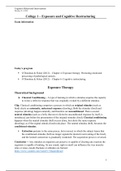Cognitive Behavioral Interventions
Dinsdag 10-11-2020
College 1 – Exposure and Cognitive Restructuring
Exam information
Today’s program
O’Donohue & Fisher (2012) – Chapter 4: Exposure therapy: Promoting emotional
processing of pathological anxiety.
O’Donohue & Fisher (2012) – Chapter 6: Cognitive restructuring.
Exposure Therapy
Theoretical background
Classical Conditioning – A type of learning in which a stimulus acquires the capacity
to evoke a reflexive response that was originally evoked by a different stimulus.
Clip: Classical conditioning comprises a process in which an original stimulus (such as
food) elicits an automatic, unlearned response (drooling). Both the stimulus (food) and
response (drooling) happen naturally, and therefore are unconditioned. Than a second
neutral stimulus (such as a bell), that never elicits the unconditioned response by itself, is
introduced, just before the presentation of the original stimulus (food). Classical conditioning
happens when the neutral stimulus (bell) occurs alone, but elicits the same response
(drooling), as if the orginal stimuls (food) took place. The neutral stimulus (bell), becomes the
conditioned stimulus.
Extinction pertains to the same proces, but reversed, in which the subject learns that
the conditioned stimulus (bell) no longer signals the desired event (eating of the food),
and the learned connection is gruadually weakened. The acquisition proces is reversed.
Conclusion→ Any stimulus an organism can perceive is capable of eliciting any reaction the
organism is capable of making. So any sound, sight or smell can influence the way muscles
relax or tense, moods fluctuate or attitudes are formed.
https://www.youtube.com/watch?v=hhqumfpxuzI
1
,Cognitive Behavioral Interventions
Dinsdag 10-11-2020
John Watson and Little Albert
In the 1920’s, Watson let little Albert play with a rat (neutral stimulus). At some point,
Watson started pairing the playtime with the rat, with a loud noise (unconditioned stimulus),
causing a natural reaction of distress in little Albert (unconditioned
response). After a while, only seeing the rat would be enough to cause
little Albert great distress, which means the rat had become the
conditioned stimulus. Interestingly enough, after some time, little Albert
started showing equal distress to Watson’s beard. Little Albert’s fear had
generalized to other white furry things.
Conclusion – Watson’s ‘Little Albert’ experiment shows that classical
conditioning isn’t only applicable to animals (shown in Pavlov’s dog
study), but that the learning process is also pertinent to humans.
Maintenance of fear
Classical conditioning can lead to the onset of (pathological) fear. It pertains to the
acquisition.
o Fear can be a reaction on a frightening object, or even be an acquired fear for
an object that was originally not frightening.
Operant conditioning is needed to explain the maintenance of fear.
o Learning through punishment and rewarding.
The two processes are both involved in the maintenance of fear, as demonstrated by the Two-
factor model by Mowrer.
2
, Cognitive Behavioral Interventions
Dinsdag 10-11-2020
When you get bitten by a dog (unconditioned stimulus), the situation can be so traumatizing
you develop a fear for dogs in general (conditioned response). This pertains to the acquisition
of fear, through classical conditioning. But then, the fear response can start acting as a
stimulus for behavior, most often through avoidance. A stimulus that gives you fear, is a
principle that leads to the maintenance of the fear itself, through operant conditioning. This
process reinforces the development of anxiety.
Avoidance learning – This process of avoidance can be studied by means of the electrical
chamber in animal studies. When the floor is set with a small electrical current, the dog will
jump over the edge to the other side of the box. If this shock gets preceded with a lightning
lightbulb, than at some point the lightning of the lightbulb will lead to avoidance of the
electrical current itself.
Classical conditioning, operant conditioning and Mowrer’s Two-factor Model are all
examples of black box theories. There’s a certain stimulus that leads to a certain behavior,
but what happens in between is unknown. A solution for this problem, is the EPT.
Emotional Processing Theory (EPT)
These early learning theories were expanded by integrating Lang’s concept of the ‘fear
structure’, to create a comprehensive model for understanding pathological anxiety.
Fear-structure is an anxiety memory, in which representations of stimuli, responses,
and meanings are stored. In anxiety disorders, stimulus representations are linked to
danger and strong responses.
For example: If you encounter a blond man with gun, you become very scared, what can lead
you to develop anxiety. The fear-structure in this case would be→ Three characters (blond,
man, gun) which are all linked with danger inside your head.
Consequences for therapy – Effective therapy = Correction of fear-structure.
The fear-structure has to be activated, so the patient must experience anxiety during
therapy.
New information must be introduced in the fear-structure, that’s incompatible with the
old information.
3





